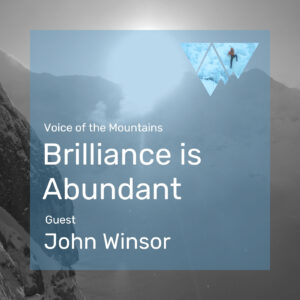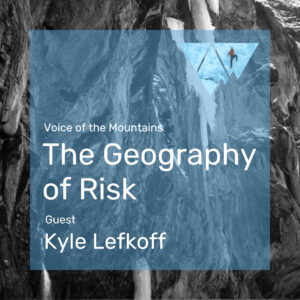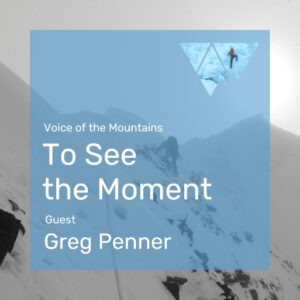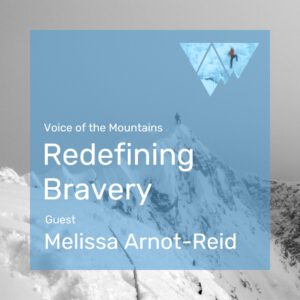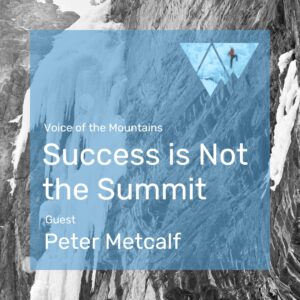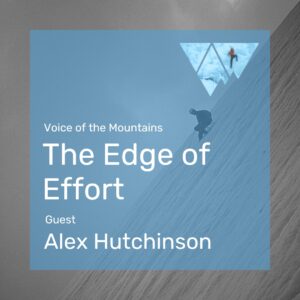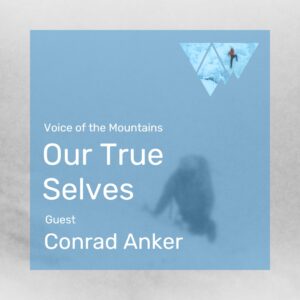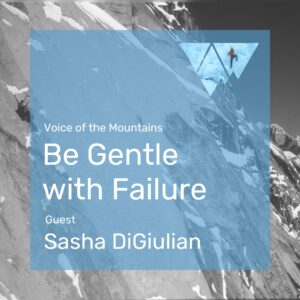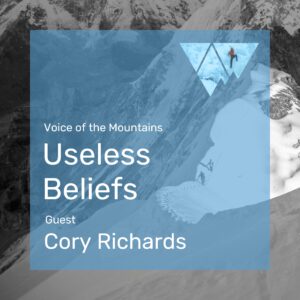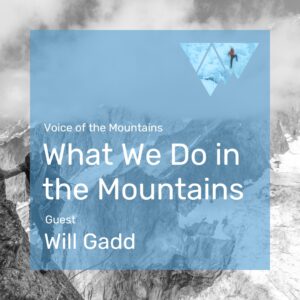Brilliance is Abundant
Guest John Winsor
READ THE COMPANION ESSAY
Exploring the poetic soul of the mountains.
Voice of the Mountains explores the mental and emotional adventures found in discovering who we are and what we’re capable of. Here we engage in self-reflection, humility, and embrace the beauty and struggle of the alpine experience equally.
Listen to More
Steve: There comes a moment when something that has always been quiet becomes clear. When you realize that progress is not measured by what you build or achieve or climb, but by how deeply you’ve paid attention while you are building, training or relating. John Winsor has lived many lives, athlete, writer, founder, boss, father, husband, researcher, and mentor. He has shaped both ideas and people across the last couple of decades of change. But what draws me to John is not the breadth of what he has done. It’s the quality of how he inhabits the present moment. The now John brings curiosity and humility. He moves through the world with a beginner’s mind that has not been lost to experience, but been refined by it. He’s still learning, still listening, and still asking generous questions. In this episode, we talk about what it means to stay open, to growth, to uncertainty, and to the people around us. We talk about becoming an elder, not by standing apart, but by standing alongside. We talk about the value of creating space for others to step into and about building both systems and relationships in a way that makes room for dignity, creativity, and vulnerability. At the heart of our conversation is one simple truth that John returns to again and again, that brilliance is abundant and how he sees his life’s work as creating pathways for this brilliance. Perhaps your brilliance to emerge. This is a conversation about leadership and about stewardship, about continuing to grow with both courage and with care. I’m Steve House and this is Voice of the Mountains.
If you’re enjoying the show and want to take the next step in your training, join our newsletter and receive a free four week sample training plan. Head on over to uphillathlete.com/letsgo, and once you sign up, you’ll instantly get a link to try out some of our most popular training plans. It’s a great way to get a feel for how we train our athletes for big mountain goals. Check it out at uphillathlete.com/letsgo. That’s uphillathlete.com/letsgo.
Steve: John Winsor, it’s so great to have you. Thanks for coming on The Voice of the Mountains podcast.
John: Hey, thanks Steve. I get to do this a lot these days, and it’s, I, when you called to, to, you know, wanna have a conversation, I was like, wow, this is such an honor. I, I just, you know, I was going through the catalog and listening to some of the other ones and whether it’s, you know, it’s Will or Conrad or Rick or Peter or, you know, like, or any, any of these, uh.
The guys, they’re just, they’ve all been such deep, good friends for so long. We’ve done so much together and it’s just an honor to be a part of the crew and, and honest, you know, obviously, you know, just our, our long relationship. Just really psyched to have this conversation.
Steve: Yeah, and it is, you know, we’ve talked about this off the record too, but you know, particularly, I, I think of Peter, I don’t know exactly Peter Metcalf, I don’t know exactly Peter’s age anymore, but you know, he’s definitely like kind of a generation or generation a half, maybe two older than I am,
John: yeah, he just had 70th birthday this summer.
Steve: Oh, he’s 70. Okay. So yeah, couple generation and a half to two generations. And so he is part of this group and in Europe, part of this too, who just did such who, and I think it was partially, you know, you guys were all incredible at your sports as climbers and, you know, different skiing and all these different ways.
And this whole thing about professional climbing just wasn’t a thing. Like it wa like, it was just so small back then and you all had these amazing careers and professional careers and in different ways and, you know, get into yours in a second. But let me start off by just sort of, what I thought I’d do is there’s so many different areas of, of your life and your experience and your intellect and your, your professional path that I’d love to dig into.
So let me just start by throwing out a bunch of snapshots and then I want you to tell me what the thread with all of these. Things are, so here’s some different
John: Totally.
Steve: You’ve, you’ve talked about yourself as an intense young kid who would sprint away from other kids, and that gave you the sense of feeling.
You talked about growing up in a family that was into publishing and you worked every job in the newsroom. You wrote the first of what I think is now six books, which was titled Fitness on the Road, which is sort of apropos. I didn’t actually realize that until I started do digging a little bit for, for inter, you know, interviewing you for this.
You, you went out to set a FKT with a couple other guys on Kilimanjaro. I mean, this is like 30 years before anyone knew what an FKT was like. It was just that, that, that wasn’t in the lexicon. When, when it was ever, that was 87 ish. You bought a magazine called Women’s Sports and Fitness. Which we turned into a very successful publication and sort of rode that whole, and supported that whole wave of, of women coming into sports through the eighties and and nineties in a big way, and allowed them to tell it their stories from their first person experience.
You were named, your, one of your agencies was named a global creative agency of the decade. You guys did creative work for brands like Microsoft, Volkswagen Best Buy, Domino’s Pizza. You also are a husband who, and you’ve spoken very openly and profoundly about this with, of a, of a, a woman who suffered from severe mental illness and took her own life as a result of that struggle, you survived an avalanche.
You at least one that I know of you. You were an early board member and a long time, long serving board member for black time and equipment. And of course we already mentioned Peter Metcalf. He may come up again. But you know, we talked extensively about the journey of black time and you, you’re a avid surfer.
You’ve that guy that has paddled out again after getting worked really hard by a wave. You founded the first crowdsourced ad agency in the world, and through that you won accounts like the Dish Network, which has an advertising budget, well I think like a hundred billion dollars a year. And Harley Davidson just one of the most iconic brands in in, in the world.
And you’re also a Harvard researcher and you launched at Harvard, uh, or helped to launch a laboratory for innovation science at Harvard and worked with teams at NASA and all kinds of incredible things. You’re now a seasoned founder. You’ve found and sold a number of companies over your career, and you’re really in this phase where I see you, that you’re just really reaching out and helping young companies, young entrepreneurs, embrace the chaos of, of business and helping people understand what work is and what work means in the modern era.
So what is, what is the thread that connects all of these vir? That’s a lot. That’s a lot of different things, a lot of different experiences, John. And then they’re also, they’re so interesting. What’s, what’s the through line?
John: Oh man. You know, that’s been, that’s the thing I’m struggling with right now, or trying to figure out, I think, yeah, I think, you know, I, I’ve been so blessed and, and I think the thing that, uh, have has always. Been the most important to me are relationships, you know, and I, I kind of came to, um, the climbing world and, you know, even though I was really deeply connected to the outdoors and in my childhood ’cause of my dad and his hunting and our adventures, it’s really the people, right?
It’s whether, you know, it’s working with Will Gadd as a young punk, you know, sport climber who was my editor at Rocky Mountain Sports. And, you know, and, and always I always wanna, you know, be around people that just pushed the envelope for me intellectually and pushed the envelope for me physically, you know, whether it was, again, will and I, you know, started, you know, paragliding together, you know, as, as kind of the first few lessons with Granger Banks out at North Boulder Park.
And, and so that’s been the big driver. I, I think, you know, the thing, I’m, I’m working on the seventh book and I’m, I’m really intrigued by this idea that, and I think it, it’s, it’s a good way to kind of encapsulate my career that, you know, I think that, um. A lot of companies have been very successful ’cause they’re op operationally excellent when they get big, right? And I think there’s a time and place in that for culture. And, and one of my buddies at at at Harvard, Mike Tushman, who’s kind of the grandfather of organizational, uh, innovation, he kind of puts it into two ca um, categories of exploit. Somebody who’s operationally excellent and can do a great job and explore. And, and then trying to create ambidextrous organizations where you can kind of do both. And, uh, I, I, you know, I would say my career has been very ambidextrous and, and the thing that’s really pushed me is to be around excellent people that push me. Um, I like kind of the zero to one thing, um, whether it’s even academically being with folks that are kind of rogue through I, I’m with a bunch of rogue element inside HBS that are really pushing the envelope. And it just makes me laugh because it’s, it’s very much similar to all the experience I’ve had in business and trying to do new things even in the outdoors, right? You, you kind of, you know, when we went to Kilimanjaro to do that, Kevin Cooney and I did, we would ask all the guides like, how long does it take?
You know? And, and people were like, well, it’s six days. Even the guys that lived on the mountain every day, and, you know, the idea of trying to do it in 12 hours was just so weird to them. They didn’t even understand kind of the, the mindset difference. So, so I’ve been playing with this idea around just this, this thing, the explorer’s mindset and versus kind of the more, uh, uh, you know, operational mindset.
And I think that’s, in my recent work, that’s super important because I think that. And, and just for context, the work I do now is how organizations will adapt or survive in this age of ai. And, and I think it’s really, really important to think about, you know, sometimes in history there’s a certain kind of, uh, organ organism organization that really thrives.
And, and for the last few decades it’s been operational excellence, whether it’s Walmart or it’s, you know, large, uh, software companies. But I think we’re entering this phase where the explorer’s mindset is really critical, right? You can’t think about, um, executing on a strategy. Um, I, I, I, I think somehow, you know, what’s happened is that strategy back in the day, right, whether it was Yvon Chouinard or Peter Medcalf, a strategy was just the how, like the vision and the mission and the purpose was, like that was the most important thing, whether it was on a climb or anywhere else.
And, and somehow now with professional managers, it’s become the what? And, and so people are trying to ask like, well, how do I get AI to fit my strategy? And, and I’ve been kind of a, a lone voice in the woods and like hearkening back to a lot of the, the, expeditions and, and projects I’ve been involved with out in the outdoors of saying, well, maybe it’s, let’s think about the purpose and why are we even here?
What, why do we exist? And then maybe we need a new strategy, a new how to, to figure out, uh, you know, how we get that done. And so I would say that’s kind of the, the theme of my career is I’ve just loved being, uh, a little bit beyond the horizon and, and coming back and kind of discovering new things. and and I’ve tried to set myself up in a place that, uh, working with a lot of people that are a lot smarter than me, that I can bring these ideas back and then they can help me operationalize.
I mean it, you know, it can be things like, I mean, one of the things you mentioned, my work at Crispin. One of the things I loved was, you know, Richard and I went to Paris and we rode Villa Bikes, which were bike, you know, sharing their bike sharing program. No place else in the world had that. And you know, I was super honored that come back to Crispin and work with my partner Alex Bogusky, and for me to say, Hey, let’s start a bike sharing program is an ad agency, you know, and, and he was into it and we did that and it blew up, it blew up globally.
And so those are the kind of examples of, you know, how can I be out on the edge and doing things just kind of feed my soul, but yet come back and be a part of a community and actually operationalize those things, right? Not, not just make ’em one-offs and be able to really do some great stuff out of that and change culture.
Steve: How much of this is create connected to that intense, energetic kid whose energy sometimes felt unwelcome? And I, and spoiler alert, this has come up with basically every guest on this podcast, right? Like this, this question in some form because so many of the people that have have been on the voice of the mountains do come in just sort of wired this way.
And they often experience, especially as childhood. Feeling like they’re outsiders, feeling like they don’t fit in, feeling like they’re not welcome. They’re, they’re too much for people. Is is that, take me into that in, in your experience.
John: Yeah, I mean, I, I always, you know, I, I don’t know. I, I, I think it was a lot of it just the way I grew up. I mean, you know, one of the things that I really admired about my dad is, you know, he got kind of stuck in a job in the Midwest taking over a family newspaper, and I. Yeah, what he really loved is he loved the idea of being outside and being, you know, being in the mountains.
And, And, so that really, you know, that really set a tone for me for, you know, for my, uh, seventh, I guess it was probably like my 12th birthday. We went on a, you know, we went on an elk hunt in, in Canada with Bose, and I’ll never forget, I almost cut my finger off and, you know, we had to ride a horse out a day and a half to the hospital, and my dad was always up for it.
Right? That was just the way that I kind of, uh, uh, you know, kind of grew up. And so I think I, that I had this seeds of this kind of. Ambidexterity, you know, dad was very serious and in the business world, and, and I got to observe that. But I also got to see this world where he would go out and lose himself.
He, you know, he’d be gone every, every fall since 1963, um, somewhere in Alaska or, or in Canada, you know, really, you know, enjoying his time outdoors. Um, and so, you know, I think there was that, but it was also, I, I think for a lot of us that have been entrepreneurs and love the mountains, you know, there’s also, there’s this otherness that we feel, but there’s also, I think it’s a lot of, that’s not just imposed upon us.
I think it’s, it’s self-generated as well. It’s something like, Hey, we wanna go do something big. Like, you know, we wanna make a, we wanna kind of. Spend the arc of history in some way. I, you know, in our little, our little way and, and I don’t know what, what that is in me that wants to do that, but it feels like I almost have a, a, an obligation to do something and, and do it in a different way to show that it can be done in a different way.
That things are new. And so, um, that’s, that’s kind of been a big driver for me for sure. And I think a theme. So I don’t know if the kids, if, I don’t know if me as a kid running away was to avoid something. I think it was more of the excitement of kind of getting to someplace new and describing it and being able to shape it and bring it back and, and, and shape culture.
Steve: So it wasn’t necessarily a, a problem you were running from, it was just a force that was within you and it compelled you forward. Like just, and that was enough, like just to go forward and then find the place and have that joy of discovery.
John: Yeah, I love, you know, I mean, one of my favorite authors is real key, and he talks about, in some of his, some of his stuff in, you know, letters to a young poet about, you know, the awful experience of, of, you know, being in a room and close to the window because you’re terrified of feeling the skeletons in the room.
And, and, but what, what more, you know, there, there’s nothing more important than like figuring out what the dragons are and going deep into that. And that’s, I’ve always been really seduced by that is like never really, you know, I probably am not. Uh, why I’m not, I’m not good at going deep into things for a long time.
Instead of asking why, I’ve always challenged myself to ask, why not? You know, that’s, and that’s been a driver through my intellectual work at Harvard and through my, you know, through my work and as an entrepreneur and certainly in the mountains of like, well, why not? Why can’t you go do that and put these, link these things together, or do it in a new way and, and change the mindset around, around something.
Steve: Yeah, I think that that idea of. You know, why versus why not is really powerful because I think that there’s, you mentioned zero to one earlier, I think that that’s where so many of us get stuck. I mean, we overthink it or you know, or we talk about it with somebody and they tell us we’re crazy, so it, we decide it’s crazy.
And it just, so many things sort of get stillborn in a sense at that, at that stage of the gestation, and they never quite come fully to life.
John: I totally agree. I totally agree. It’s funny ’cause I, if I reflect on my career, I, the best motivators were ones when people told me I couldn’t do something. Like, you know, one of my friends told me for my first business book and second book, like, oh, you’re not smart enough to write a book. Or, you know, when I bought Women’s Sports and Fitness and I had a regional title, they were like, you’re not, you know, you don’t know what you’re doing in national publishing.
You could never do that. And to me it was just like, ah, that’s great. I, that’s exactly what I needed to hear. I needed to hear that. There’s no way I’ll be able to do that. And just so I can really dig in and fig figure my own way out. So.
Steve: Mm-hmm. I’ve had that experience as well, when with, with exactly that, where it’s just like, I don’t think I immediately recognized it as being that juicy kernel of motivation I needed. But over time I was like, yeah, that’s, that’s really like, I really good. It’s somehow motivating me, uh, to, to, to keep showing up and keep digging in because there is a, is a way I just have to, nobody’s figured it out yet.
John: Exactly
Steve: There’s this fundamental. Truth, at least I see it as a truth. You can shoot holes in this as you see fit, but that, you know, the harder a problem is to solve, the more value you create
John: for sure.
Steve: as you work through problems. Because it’s always, it’s never just one, it’s a series of problems that, you know, every time you hit something hard, that feels impossible.
I tend to tell myself like, oh, this is really good because this is where 80% of the people who get this far are gonna turn around. But I’m not gonna turn around. I’m just gonna like toiling and I’m gonna figure it out eventually. And, uh, and I think that that’s like a, a, a really, for me, that’s been a really powerful framework also in, in, you know, trying to run a business and solve.
Create value for athletes and you know, it’s like, well how do we do this? You know, we’ve got some stuff that I’ve been working on for a while in, in that way, and it’s been really hard to do and I feel like this is great because it’s gonna take other people a long time to do it as well, or at least long, you know?
So I think, I think that that’s really interesting that that motivation, and I don’t, I used to judge it as sort of dark or negative, like that kind of motivation, but I’ve, I’ve stopped judging it and just let it be. Now have you had any experience with that? Do you.
John: Yeah. Yeah. In fact, I had a, you know, like I, I’m always in awe of, of, of those of us who decide to take, you know, the alternative route. And I, I was just in, in Portugal and went out to Nazare just to see, to see the wave, right. And I was in awe of Garrett McNamara. Like, what a, like, what a crazy story of him just going to this fishing village and just, you know, like, the wave looks impossible, looks like this massive, you know, at the time when we were there, it was 30 feet, but it was like this huge closeout. And for him just to work it and work it, and work it and work it for years, you know, and just figure it out and, you know, nobody else was willing to do that. And, and, and I love that, right? I love the fact that somebody’s just so gritty and determined to figure it out when everybody else, and all the other signals are saying, don’t do it, or.
Steve: So tell me more about this story. He discovered this or heard about this big wave and went out and figured out how to surf it. Is that the story?
John: Yeah, no, the story. And, and then now there’s this big documentary on, on HBOA hundred Foot wave. And, you know, Garrett was a, a good surfer, but, and, you know, hadn’t really proven himself and, and struggled. And then, you know, lad Hamilton and those guys discovered toe in surfing and Garrett really took it seriously and got really, really good at it and was world champion for a couple times.
And then this wonderful story of some fishermen from Nazare, Portugal sent him a note ’cause he was all over, you know, everywhere as the best big wave surfer inviting him. And he didn’t even believe it. It took five years for him to look at the pictures. And finally his wife pushed him to say, we should go visit Nazare. And you know, he. I mean, the wave, when you’re in Nazare, you’re on the beach and it’s right there. Like it’s just down and you can see it, you can see the point and everything. It’s not like it’s a hidden place, but it takes like anything, right? It takes like, you gotta get in the water and you gotta experience it and you gotta, you know, get terrified and you gotta make mistakes. And over a few years, just him hacking together, the resources to make it happen has put this whole town on the map and it’s really created an unbelievable economic value for the people of Nazare. And it’s become an, become an epicenter for surfing. Really, really big waves. And it’s just really awesome that, you know, somebody had the courage to. Go surf surf Jaws or Mavericks or you know, the tried and true places, but really go off the map and, you know, make a really difficult path for themselves to do something. And I love that kind of explorer’s vision that the, you know, the willingness to kind of say, I don’t need to take the path that’s already been cut for me.
I can go take these tools that I’ve learned in these great places and be able to go, you know, do that in a new, in a new place.
Steve: I think it won’t come as a surprise to anyone listening to this, that grit is part of being an entrepreneur, part of, you
John: For sure.
Steve: bending the arc of history in some small way by our, by our, by our presence here. One of the things that I think they might not be so obvious, but I really resonates with me is the power of empathy.
And, you know, you’ve talked really openly and. Uh, powerfully, I think, and, and, and I’ve told you this before about your wife Bridget’s battle with, you know, she had a late onset, late in life onset bipolar disorder and she took her own life. And this is really not easy territory to enter and you’ve chosen to share it.
And I I, when did it’s been, you know, there’s been water under the bridge now, and I know that personally that you’ve had opportunity to heal a lot of that, but also something like that. And it, it’s not, it, it’s always a part of you. You, you, you said that, that that taught you something you couldn’t have learned any other way.
What, what, what was that that you, you learned or what, what died in you when she died? What, what was reborn in you through that, this journey of, of grief and, and, and healing? I.
John: Yeah. And those are, those are really wonderful questions. You know, for me, I would say I’ve always had this weird character, and I think a lot of us that, that do the things that, that we do, you know, we, we do have a lot of empathy because we’ve gone through a lot and a lot of people haven’t made it through.
And, and so, you know, it, it’s driven by that. But I, I think that. That idea we talked about a few minutes ago is not excluding an experience, you know, and it’s like as tragic as, as, Bridget’s journey with mental illness was and her suicide. It was, it was, you know, it was an honor to be there with her and it was terrifying.
Oh my God. I’ve never been more terrified in my life. It just, you know, the, the partner, Bridget and I were married for 32 years and getting like long laid onset bipolar with just, you know, her. She had a three year journey through the darkest of times, and none of us knew what was happening and. It took me a long time.
I, I, I probably will never completely heal from it, you know, it’s a scar that happened, but I think it starts with acceptance, right? That we’re here for such a limited time and it’s, it’s our choice, right? It’s our choice on how we, how we live in the world. I think, you know, we’re entering that age. You and I, I’m a little ahead of you, and I just, I, I’m just sad for a lot of the people that we have known over the years that just seem so desperate to re grasp what they’ve accomplished in the past or lived back there.
And it’s just like, it, it’s, it’s just sad because there’s such a beautiful world out here to like explore and touch and push beyond. And so I would say, you know, Bridget tried super hard. It was an honor to be on that journey. I don’t, I don’t see it. Is any other, any other outcome? You know, there was just, we all tried super hard and it, it is what it ha it is, you know, it’s, it’s like, it’s like I, it reminds me a lot of being in that avalanche with, you know, that industry trip we were on with Jack t and Kim Miller and all the, you know, when we were all 12 or 14 of us took a thousand foot ride, you know, um, it was the same thing.
We did everything right, right. We, we dug to the right pits, we had the right people, we did the right systems. And still you have danger that happens and,
Steve: We were skiing with super experienced mountain guides that knew the area. I mean, it was, it was Ken, right? Was one of
John: Well it was Rich, rich, Marshall, rich
Steve: rich Marshall. Okay. It was with Rich.
John: Yeah. And, you know, we did everything right and yet it still happens.
And I was really fascinated even back then of like, you know, I think there are four or five, five couples on the trip and, and three divorced after that. And, and a lot of those, a lot of the relationships fell apart because of different, um, willingness is to accept the past. One person in a relationship would be like, holy shit, I’m never going outdoors again, or I’m never going into the back country again.
And the other person would be like, yeah, it, it happens. It’s the way it, it goes. And it was just unfortunate that there was so much collateral damage from something. And, you know, I, and I saw that with Bridget. I mean, I can’t tell you how many people, um, you know, took sides in a really ridiculous thing or blamed me or blamed, you know, just this weird thing, this kind of cause and effect. Um, I and I, for a while I was really hurt by that. Um, ’cause I tried super hard, but
Steve: I can’t imagine that would be hurtful.
John: Yeah, yeah. So many friends that I lost, but on the other hand, I’m just, I’m sad for them. Right. I’m sad for them that they are holding onto that and that they can’t get over that. And the way I look at it is, you know, hey, you know, we both had the experience of some people’s, you know, their bright lights and sometimes the brightest, you know, candle burns the shortest.
Then, my God, you know, what a great honor it is to have a journey. You know, I had a journey with Bridget for 32 years, and it was amazing. You know, since I’ve, I’ve remarried, I’ve remarried Emily and Emily’s equally as amazing, and I, I think that’s the thing that I’ve just loved is like, holy shit. Like, how did I, how did I do this?
Get to marry two amazing women in a lifetime, like I am the luckiest guy in the world. And, and, and it’s very different, right? It’s very different experiences. It’s
challenging in different ways, and I love that, you know, it’s, I think it’s the. It’s the same thing. You know, I, I got into surfing late in life and, um, you know, when I sold the, the publishing company, I went to Mexico and, you know, really decided to start exploring that.
And it was so hard, you know, I think a lot of us that grew up in the mountains, no, just you get in the ocean. And I was like, wait a second, I can’t control anything. I can’t even stand up. Like, what the hell? And, and yet it’s been so gratifying, you know, it’s been so gratifying to be able to discover new nuances, I think. I think what’s interesting to me is, is that beginner’s mind, whether it’s in relationships or it’s in activities, like there’s this freshness that you have when you start something new and it could be just a new climb in a new area or being, you know, at a new break. But, but there’s a beginner’s mind that has to happen that, you know, it’s, everything’s so new and fresh and scary and, and that’s a really exhilarating thing if you allow yourself to, to live into that.
Right.
Steve: Yeah. And it’s very difficult to have that with something that you’ve been doing for your whole life. You know, for, like, for me, for me, with climbing for example, like, I mean, I don’t, I, I get to experience that a little bit through my kids ’cause take, just taking them climbing again. And like, they’re, they’re young and so they’re just learning basic things and it’s like, oh yeah.
And it kind of brings me, brings me back into that. But I, I still am the person that I am and have the experiences I had. So I can’t fully reoccupy that, but I, I can appreciate that. And that’s one of the things that I really like about, um, you know, coaching and running uphill athlete is I, I’m much more in this beginner’s position and it’s really, really fun.
There’s just so much to learn.
John: Yeah, it must be fun. It must be fun because I, I so admire what you’ve done in helping so many people and everybody has a different approach and a different problem, and a different goal, and trying to hack that and figure out exactly what the components are to make them, or to help them achieve what they wanna achieve must be a really cool thing.
Steve: Yeah. It, it, every problem is different, right? Like that’s, that’s, you know, it, it is and it isn’t, right? Like there’s basic frameworks, basic principles that are universal, but then the, the individuals, the people are, are all different. Like you said, for all those reasons. You, you won’t be surprised to know that, you know, this topic of risk and mortality has come up on this voice of the mountains a number of times.
Given the, the list of, of guests. I think it’s, and you mentioned this earlier about how different people after, particularly after this avalanche, was it in the cell, Kirks? Is that where you guys were?
John: Yeah, I was in rks, right, 93.
Steve: You that different people, and it was, you had these sort of almost ab tests of these couples that would react very differently.
And I, and I know exactly what you’re talking about. I’ve so been through this with both personally and with other people, and know exactly what you’re talking about. Uh, what, what is. What has changed with your relationship for risk? With risk, because that is very personal and everyone has, as you pointed out, rightly so, everyone has a different sort of response to these, let’s call them near death experiences, for lack of a better word.
It could be a near death of yourself, or it could be the actual death of someone you’re close to. I consider that to have a similar impact, like your best friend or your climbing partner, maybe if they weren’t even climbing with you, or maybe they were standing right next to you. But all of these, and, and then in, in our lifetimes, I know we’ve both experienced this multiple times, you know, more times that we care to, to recount.
That’s a, that’s a, that’s an outlier. Let’s, let’s set that aside. H what was your personal experience with that?
John: I would say, you know, I, I would say I, I look at risk very broadly and it, you know, risk is a really important thing, you know, whether it’s, you know, climbing something that’s difficult for me, or, um, riding my bike really fast downhill, or, you know, trying new sport like, you know, riding motorcycles or, or whatever. Um. I, I, I’ve tried to really break down what that feels like, what that means. And what I’ve found is that you can, you can put yourself in the same situation intellectually and spiritually. Um, I, I think that as I recount my experience at Harvard, I mean, I’m just a dirt bag climber. Why the hell would Harvard want me to come help them out? And so I feel this, right? Like, how do I be authentic to myself and still like, be there? And when I, when I’ve given up, you know, again, you know, being kind of more grounded and really trying to think about the deeper mechanisms. I fucking love it. It’s so awesome to be in a room when you’re the dumbest person for sure. You know? And being able to just be really curious and really open to like, it’s totally cool. I’m not very smart here, but. When you come from a perspective of that and you’re just, you just kind of really enjoy the challenge and the risk of like, I could sound super stupid to somebody, you know, who I’m trying to gain their trust or, you know, understand a big problem globally. It, it feels kind of the same as the risks we’ve taken in the athletic, you know, the, in our athletic careers. And, and I would, I, I, I just find that that’s the mechanism that I’m really turned on by. So I might not push myself as hard and, and have the same risk tolerance physically for a lot of reasons. But I, I also can transfer that over to be really challenging, you know, or challenge myself from a, from a risk standpoint intellectually, uh, in relationships and things like that. And I think that’s, that brings me as much joy. Um, you know, so one of the things, I don’t know if you and I have talked about, but I had prostate cancer this summer and so I had my prostate removed, um, in July and I found it so curious, right?
I found it so curious. Um, I’ve kind of really enjoyed the new experiences. I mean, you know, there’s so much fear around cancer and there’s so much tar, terrifying, you know, people are so terrified. So I didn’t tell anybody beforehand ’cause I like, ah, I don’t wanna deal with it intellectually. I’m like, you know, the, the burden of like trying to keep people up to speed and, and so, you know, it was something I’d been dealing with for a year and a half or so. And then once I had. Been involved, you know, going through it, even through like the incontinence and things like that, it’s kind of been like, wow, my body’s changing. And it’s such a weird thing and it’s super interesting to experience. And, And, and one of the things that I’ve really come back to is, have you ever watched Anderson Cooper’s, um, podcast series around, you know, death and, and grieving? I dunno if you’ve seen that. Yeah. There’s a great, there’s a great interview with Stephen Colbert. And Stephen Colbert had a situation where his, his, dad and his, I think his brother and sister, or maybe just his brother, um, when he was 10 and died in a plane wreck. And, you know, people, his perspective is so beautiful and it’s one that I’ve tried to adopt and that is he, he said, you know, people say, oh, I’m so sorry for you and I’m so, you know, like, you know, there’s so much, um, empathy, you know, and, and people try really hard and, and, and they, people feel very sorry for you, but. As Colbert said in the interview, he is like, I feel sorry for ev for everybody that hasn’t had the chance to experience the whole, the whole spectrum of emotions and emotions of like losing somebody when you’re young. Like, what does that mean? And I, I, I feel very honored whether it is like having to be. Having to go through the difficulty of a partner that struggled and then eventually committed suicide or having cancer and having that experience. I mean, it just, whether they’re positive experiences or they’re negative experiences, they’re still human experiences and they add to the overall perspective you have in the world.
And I, I’m really turned on by trying to experience those things and trying to be involved, you know, and, and, and not just experience them as a flippant, like I’m gonna go do that, but more meditatively of what does this feel like? How does it feel to do that? I mean, you and I have both wrote written books and I, I, I don’t know anything harder than writing a book in my, my life. It is so hard. And so you have to dedicate yourself so much and everybody’s taking shots at like, this is good, this is bad, all that stuff. But man, I’m so glad I’ve had those experiences. Right. It, they’re awesome when they’re over.
Steve: Yeah, yeah, yeah, yeah. And then there’s this, uh, as collabor, we have this. Amnesia and then we, we do it, do it again a couple years later. So,
John: Right, exactly. Exactly. Exactly.
Steve: I think that’s such an incredible, I just wanna touch back on, I mean, what you were saying a moment ago, ’cause so many incredible insights and such beautiful insights and so much to learn there and unpack.
I think that, how do you, for me, the key thing that you said in all of this was the, that to be almost meditative in your openness to the experiences and deeply try to feel what it feels like, what that human experience that you’re going through is. And, because I think that so many of us are armored up, you know, probably from childhood or whatever, and we’re, we’ve walled off.
Emotions and, uh, and because they’re bad, we’ve labeled them as bad. So we don’t go in that area, that that’s like a, a closed door and we don’t go through it.
John: Yeah.
Steve: And so, and, and, and I tried so hard, like we were just talking about mortality. And I tried so hard to do that with the friends I lost in the mountains early on.
And it was so hard for me to, it was so crushing, really, like it felt soul crushing to,
to lose some of these friends. And I, it was like, I mean, wasn’t my brother or my sister or my father, like what Stephen Colbert experienced? But these were like really good friends that were just, you know, gone ripped away.
And I tried. So like those experiences, I think what they teach is that there’s no way, it’s, it’s so intense. There’s no way to wall it off. You can’t not feel it. You can’t not experience it. You don’t have to have this meditative approach to it because it just, it’s so intense. It just like comes right through.
Whatever armor you put up, it’s just like, it’s coming through, it’s coming at you, it’s hitting you, and there’s no hiding. And I had to do that a few times, you know, where I went through this, like trying, trying to keep it out, not being able to, and then like feeling like I had to give up, you know what I mean?
Like I had to surrender.
John: Yeah.
Steve: And then after I did that, it was like, oh, I actually didn’t get worse. It actually somehow gets better, which is strange. And, and it was just sort of the, the, the opposite of what I expected. Of course, it took kind of years for all of this to unfold. And I, I hear a similar experience in, in, in yours and like how you’re open to all these, you know, I mean, who wants to have prostate cancer and go through incontinence?
I mean, what, you know, or have their wife commit
John: I love my Depends. I love my depends.
Steve: yeah, I mean these are some of the like, you know, if you had told me any of these things, I don’t know, even 10 years ago, I’d just been like, I don’t, I wouldn’t have been, I wouldn’t have been able to handle having a conversation with you about that.
Like, I would’ve been so impacted. Right.
Um, and I think it’s so interesting how vital that mindset is to working through hard things, solving problems, and I think building empathy. And I think one of the things with marketers that has always been fascinating to me, and I learned this in my time at Patagonia when I started to work with the marketing department and there were, I started to come in con for the first time in my life there.
I came into contact people with people who had like this empathy superpower that was just like, to me as a person who had been walling off. Things and other people’s emotions, my own emotions, and to be around people who could just like completely read every emotion in the room, like in a heartbeat. I was like, what?
Like what, where are you getting this information? And then just slowly starting to, to learn. And then of course, they’re using it also for commercial purposes, which is, I think one of the things that makes a really good marketer, right, is someone who is empathetic and can understand how, uh, words or, or images or, or moving images can make people feel, right?
Like that’s what you have to be able to understand as a, as a good marketer. And, and I think that that comes from having to learn about these experiences like what Steven Gobert said, what you said. I mean, I think that a lot of, a lot of those things kind of come together for me right now as you’re talking about that.
It’s really, so thank you for that. That’s
John: Yeah, man. Yeah. But as you talk, one of the things I reflect on is like, you know, I, I think like you, you know, and like all of us have done big things. We know the importance of preparation and we, we take it very seriously and we’re really thoughtful about it. And so I had this experience a couple years ago when I did my first psychedelic journey. The guy who is gonna guide me on this, this journey was like, I want you to prepare a shrine with everything that’s important for you in your life. And so. You know, like you would do, or most of my friends, you know, that are, that have had similar journeys, we take it really seriously, right? We write down lists and we then we look at items and we create, you know, like, it, it’s like weeks worth of work, right?
That to figure out exactly how I structure the shrine with all the important events in my life and all the important, you know, people and, you know, some of it’s very egotistical ’cause they’re our accomplishments, quote unquote, and some of these deep wounds that we’ve had because of our relationships.
And, and so I did this right? I spent all this time and I put it up and, and partway through the journey, the, the guy was like, look at your shrine. What do you think? And, and I literally just busted out laughing. And I just, I, I, you know, the conclusion I came with when I had the, the. The, the help of, uh, of, of the psychedelics was that it doesn’t matter. Like, it’s awesome. It, it’s such an honor to do that. But the only reality that we have in life is this moment right here that the, the conversation you and I are having right now, it is the only reality that we live in. And so if you can do that, if you can say, man, I am so lucky to have all these different things that have added to my ability to perceive what’s happening and add maybe something constructive to the moment that I’m living in now, that’s awesome. But that’s what it is, right? It’s just this kind of really beautiful tapestry that we’ve had the opportunity to weave and be a part of that gives us the ability to show up in a new way right now, right here. And, and, and that’s what I really love, right? That’s what I, I crave those experiences, these conversations, not for honoring or storytelling about. The incredible experiences we’ve had, but more like how does that influence our conversation? What does it mean? How can we, what can we share from our own journeys that maybe somebody listening could, you know, take something away and it could help them have a brighter day or laugh a little bit more, or, you know, take themselves a little bit less seriously.
And that’s my hope, at least.
Steve: Hmm, hmm, hmm. Yeah. You know, it’s, it’s that I think it’s, I, I don’t know where it is, but I, I, to me it’s in like the Old Testament or something where this, this parable of like, you know, I ask God for wisdom and he gave me problems to solve, solve, right? It’s like I asked God for empathy and he gave me tragedy.
You know, I ask, you know, it’s like, it’s like, it’s not really what you’re asking for, uh, directly, but it, it’s, this is actually how you get it. And I think that that’s, that’s one of the, one of the things that I think climbing taught me was, and, and, and ’cause it just beats you over the head with it relentlessly, is that it’s just, you’re, you, you have to always be the process.
And, and it used to. Really annoy me as a, particularly when I was working more in my, the professional era of my climbing career where, because the, the journalists only cared about what you just done and what you’re gonna do next.
John: Mm-hmm.
Steve: sense of like, what, where are you now? What are you working on now?
What’s important to you now? And I, I didn’t know how to articulate that. Hey, this is the questions you should be asking. Like, don’t ask me about what my next trip is next summer. Like, the chances of that even happening are like, you know, one in five and then there’s all these other variables and maybe there’s gonna be a malice revolt.
And again, in, in Nepal, we’re gonna have to go somewhere else. Like, and, but what was interesting is like, what are you going through now? What are you working on now? How are you improving this year? What, what, what are you working on? And it’s like being an athlete, you’re always, you know, there’s always something to work on.
There’s always, and, and I think that so many of these interesting. How did you put it? This tapestry of life? There’s so many, and I feel this way too. I, I so wish I had, I’ve said this before on this podcast, but I so wish I had like a hundred lifetimes. ’cause there’s so many different things I would like to live that I just feel like I don’t have enough time to live all of these things.
So it’s a little frustrating, but
John: I, I love, I think, you know, one of the things that, that’s, well, one of the things that sports gives us, and you and I have talked about Nordic skiing. You know, I, I, I just find it fascinating when you get something into, into something so much, you know, and I don’t care if it’s rock climbing and the way you look at rock, or you and you feel it, or it’s back to Nordic skiing and you know, like the art of riding a flat ski, it’s existential, right?
It is like the coolest
fucking thing in the world. It is so hard to achieve. But man, when you get in a really good V two and you’re in a race and you are flying and you are on a flat ski, that continues to accelerate. I, it, I don’t know how to describe it. I can’t describe it. You know, it, it’s the same thing as surfing a big wave, right?
When you’re in the sweet spot and it’s just this, that’s what I crave, right? I crave that, and I think it’s all, it’s, it’s all throughout all of our lives, and we just have to pay attention enough to the moment to find those little flat skis in our lives, right? How do we get there and glide and continue to accelerate?
Steve: Yeah. And you know, I, we were talking about this earlier and I wanna bring it back to your work a little bit ’cause I, I wanna ask a, a few more questions about that. Is this idea of. You know, how did you put it? Uh, explore and exploit and being ambidextrous, being able to do both. And one of the things that I think a lot of people in all kinds of professional careers, they, they go through a period where they explore and it kind of leads them into a cul-de-sac, right?
Like you, you, you get good at doing something, but eventually it sort of is a dead end in some way. And then if, if you wanna stay there, that’s fine. Like you can stay there and you can keep doing that thing at that rate, and you can live your life. And it’s pretty predictable. But sometimes people want to like find the next level and then you have to kind of figure out how to climb out of this cul-de-sac.
That actually requires different people in, in many times in, you know, different team members, different coworkers, a different structure at work. Uh, and, and this is something that, you know, I’ve personally been, you know, with, with uphill athlete, we’re this extremely flat organization. That’s how we want to be.
Like all the coaches get paid the same for the same work. There. Of course, we have different coaches with different levels of experience and different expertise and certain things, but we come together as a team to help solve problems. And it’s like, this is like what we talked about, what we want, what our purpose is as a group of coaches, right?
And, and that’s been, but we’re, we’re also, I’m, I’m looking a little bit into the future. Maybe it’s a year, maybe it’s five years, I don’t know. But at some point in the not too distant future, as I see us continuing to grow at the rate, we’re just, if we just continue our current growth and bringing in new athletes.
That flat structure isn’t going to serve any well anymore. We’re going to need to evolve that. And so I’m starting to have this conversation with people like, how do we do this and maintain our values of being a peer, a group of peers, and equals? And this is the kind of stuff that you think about. I mean, and Harvard, you’re, I may get the, the terminology wrong, so please correct me.
But you know, you have this project called Open Assembly and you’re working on open innovation. And my understanding is that you’re fundamentally trying to create opportunities for people with adjacent knowledge to a traditional silo. And that with the, and you have this beautiful summation where
John: Yeah, brilliance is abundant and opportunities are scarce.
Steve: brilliance is abundant and opportunities are scarce and. You know, how does this, like when you are thinking ab this is what you’re thinking about all day with what kind of the problem, like I, as a small business owner, I’m having, and of course at much, much larger, more important organizations than ours, but the, how do you go about thinking about that as a team of researchers?
Like, what does that actually look like? What do you, what are you studying?
John: no, that’s a great question. I, you know, I think one of the things I love about the Harvard work is that everybody’s kind of doing their own thing, right? Everybody’s kind of thrown into the cauldron and chasing their own, you know, their own creative. Niche and those that create momentum get rewarded. You know, they get more research dollars and more, you know, prestigious, um, you know, in prestigious journals and more cultural momentum and all those things.
I, I, I think for me, you know, I think we’re in the beginning of a revolution. Ai, you know, and there’s a lot of other things we could talk about, you know, the change in culture and those things. But I think if we focus on, you know, what’s happening in the workforce and what’s happening for large organizations and small organizations like yours, I think we have to start with this idea.
And, you know, this is just influenced by my own life, this idea that brilliance, abundant opportunities are scarce. And I would say that the place that that’s really been most profound that I’ve felt is, uh, adopting here in Charlie from the far east of Russia, from Vladi, BOS stock and hookah. And, you know, they’re 24 years old.
And so I often think, you know, today like. If they, if we hadn’t had the chance to connect the likelihood of those guys being in an orphanage and, you know, having, uh, you know, not no education, they’d probably be on the front of, of the war in, in, in Ukraine right now, you know, that would be their, their path.
And so they’re, they’re no smarter than any other kid. They’ve just have been given some opportunities and they’ve, they’ve grabbed it and, and I think that’s what everybody wants. Whether, whether it’s, you know, the kid in Kenya who, who really loves computers and wants to be a so, you know, software engineer of like, why shouldn’t he have the same opportunities as you and I do?
Like, or the kid
that grows up in Chicago really wants to go climb in the mountains. Like, you know, it’s, it’s like how do we open the aperture of opportunities up? That’s my long-term, like my goal. That’s, I think the through line for my professional career. I would say that. You know, because of the ability to have these agentic tools, these LLMs. We’re on the cusp of really changing our mindset. A lot of the frictions that we’ve had in organizations have been because it, we had scarce resources and we had scarce, you know, scarcity mentality of only a few people in the world can do this, or only a few people. You know, there’s, there’s like scarce knowledge and all of a sudden if you have a world where anybody in the world can, you know, use an LLM and be 90% as good as anybody else in the world, how awesome is that? And I, and I think what, what happens in, in organizationally, what I’m seeing and what I’m really thinking about is that, you know, we need to think about tools like AI going from point solutions to, to more re-architecture of organizations. Like, yeah, you could look at AI as a tool and you could say, yeah, it can save me some time on some things.
But what’s really called into question of like, how do we. What is an organization? How do we build organizations? What does that mean? And so the thing that I’ve really been focused on, on a micro level is I, I think that the, that the unit of work at an atomic level is changing. I think we’ve always thought about it as people, like what builds businesses people do, and, and, and, you know, how do we get the right people?
And, and the, as you’ve experienced, like getting the right partners, getting the right people, you know, all that kind of soft work is really, really hard.
Right? It’s really hard to know and assess where people are and how they’re doing. And, and so in my latest work, I’ve been thinking a lot about this idea of assessment being the new atomic. Unit of work. And what I mean by that is if you think historically, you know, it’s like the stuff we do in sports, right? He is like, you, you have a training program, you, you know, you do the training program and then, and then you assess where you are and, you know, a week and a month and a year, whatever that is. Um, what I think we’re ha what what’s happening and what we have the ability to do is to change the, the atomic unit of these kind of new kind of loops between learning and assessment so that we can actually build real time assessment into the learning itself. We can see how fast we can adapt and we can grow and we can solve problems not next week or next month.
But, you know, the, the systems I’m most intrigued with in the work that I’m doing are companies that are building the ability for a freelancer. Let’s call in ni, you know, Lagos, Nigeria, to be able the best, you know, AI. Software engineer in the world because they have an ai, you know, ag agentic coach that examines everything they do in their learning journey and in their work journey. And continuously gives them constant feedback saying, you know, like, Hey, that, that was great that that code you just wrote, but here’s, here’s a way to do it 25% better. And, and, and so we, we build these kind of learning loops so that we’re creating velocity for the people that we work with. And I think that applies to every organization.
Right? I mean, imagine if you had the ability for your coaches to have, uh, agentic, you know. Coaches, coaches that allows them to kind of examine like all the data, all their athletes, all the things that are happening every day in the work going, Hey, the, the, that was great. Some of your athletes are succeeding and some didn’t today, and here’s some suggestions on how to change your coaching approach that might get more to be more successful or attain the goals that they’re trying to achieve. I, I think that’s amazing, right? But I think it means that we have to restructure what we do. It’s, we have to kind of say, instead of, us trying to get tools, we, we almost have to re-architect our systems so that these agents become coordinating layers, right? Coordinating the data, giving us feedback, almost managing our activities so that we provide better outcomes for the, for the people that we work with. Um, so that, that, that’s the area I’m exploring. I think it’s really interesting. I think it applies to every business, right? If you’re hiring a, you know, my God, like in the, you know, the thing that I’ve. Into the last couple years is, is contingent work and freelance, but watching organizations take four to five months to hire a software engineer when, you know they can go to an open platform and hire somebody in two hours and just imagine having the trust of knowing that their last keystroke, you know, they, they’re at the 95% level of, you know, of being able to accomplish what you need to accomplish. I mean, let’s take all the friction out of matching great people with the tasks that need to be done to cr create accelerated work. I, I think that’s what’s fascinating to me.
Steve: Mm-hmm. Yeah. Uh, so I’ve, I’m gonna talk about this on the podcast. I’ve never, I’m not really ready to talk about this officially, but. You know, I am, I’ve been working on something along the lines of what you’re talking about for the last year and a half, and so what I’m trying to operationalize, there’s a couple layers to it.
One is a dashboard for a coach. So one of my coaches will open up their dashboard in the morning and they will see a prioritized list of athlete needs. That is, you know, the, the a, we’re connected to the training peaks through the API It’s coming in. We have an agent that I’ve spent a lot of money and time and, and put a lot of IP into training and teaching, and it’s doing exactly what, what you’re saying.
It’s, it, it’s sort of the AI with a human in the loop and it’s really interesting. And then the, the other layer of that is to build a dashboard on top of that. So I, as a manager, can make sure, can see how all the coaches are doing and then creating KPIs like, you know, who has all their athletes programmed out for the next seven days with their workouts, who, or, or doesn’t.
And I can, you know, and so it’s, it’s been very effective in our internal trials, even though it’s not the, the tool isn’t working as well as I want it to yet. Uh, but it is, it is allowing us to see like, okay, because there’s patterns. Like, you know, I didn’t realize that one of our coaches was kind of consistently a little bit behind on his programming.
Not a big deal. He always got it done, but it was like he just needed that little nudge. Now he knows we’re watching and guess what, like those athletes are scheduled out all the time. Like there’s no, there hasn’t he, you know, once he, and, and ’cause it actually is no more effort. And he realized that, and he changed his, his habits and now he is doing an incredible job, but he was always doing an incredible job.
But maybe he was only programming out three or four days at the time instead of seven days, which is what I’d like them to have out. And, and I always tell people, like, tell your athletes it’s like a weather forecast seven days out, you know, it’s like 50 50 that that’s gonna happen. It could completely change, it could be blue skies or a thunderstorm, but you’re predicting blue skies for that days.
And, and, and that’s, and that’s the way coaching is and that’s the truth. So I think that this has been really good and probably what I’m really interested to talk to you about, and we can talk about it later perhaps too, but is making people comfortable with this.
John: Yeah, that’s the thing.
Steve: We haven’t adopted this like in a, like, let’s say a full way because as I said, the agent agentic tools aren’t working as well as I’d like.
And I also am like, Ooh, I need more time to bring people along to this new way of working. ’cause they’re very, some of some of them are like, you know, you have the, it’s like anything, you have the early adopters, you have the people who are kind of in the middle, you know, where people are like, no, I’m never gonna do that.
And uh, and it’s been a lot of work on the human side and I haven’t been doing a very good job as a, as a leader in helping people come along, uh, to that. It’s, and it’s scary, right? Like it’s scary for me. It’s scary for them. I mean, my pitch is like, Hey, you know, we’re all gonna be more efficient. You’re gonna be able to work with more clients, do a better job.
Uh, we’re gonna be able to prove to our, our athletes that we have these quality control measures in place. So we know that this high standard that we, that we. Offer is being met every time across every coach, across every athlete. And these are really powerful arguments. We can, we can make these and we can deliver a better service.
So it’s, it’s a win-win. But there is this sense, this resistance to, I don’t know, you know, it doesn’t matter what the details are in a way, I mean, it matters, but there’s always, it’s like an, whether it’s an environmental issue or they’re worried about like a big brother, like they don’t, you know, humans are humans.
They’re feeling their emotions, as you said. They’re feeling their feelings. And it’s been very interesting for me to like, have to slow down
and feel that with them and like sort of take the boogeyman outta that feeling. Like, yeah, there’s a lot we don’t know. And this might be terrible for the environment, or we may solve that problem in a couple years.
I don’t really know. You know, like I, I don’t have all the answers and I have to be okay with that too. And when I’ve been talking to other people, this, I, I, I’m sure I’m not alone in this as a, as a small business owner that is, is working through these things, you’re smiling. So you must have seen this.
John: Yeah, no, I think everybody has the same feelings, right? It’s terrifying. It’s terrifying to think that, especially in, you know, in coaching and in things that are very heavy on kind of, you know, co cognitive, e excellence, you know, figuring stuff out and I mean, I think there’s some, I think there’s a couple things.
One is there’s a, there’s some. Least some tricks that were kind of, uh, you know, observing. In some of our research, we did some research with p and g and what we noticed is that when you move AI from being a tool to a, to actually a team member naming it, being a part of it, you know, it’s like, Hey, Joe’s here today.
He’s gonna help us out. You know, like, just go to Joe, ask the questions. That kind of personification all of a sudden, like the, the, the, the, in the research that we’ve done is like, the more positive emotion for adoption is much, much higher. Instead of like, oh, I gotta go learn the tools for myself ’cause I’m competing against 10 other people on my team. It’s more like, no, Joe’s a part of it and it’s gonna be open. We’re just gonna, you know, query Joe to kind of ask questions and build models and help us all out. And all that data’s gonna be on the, you know, open and transparent. Uh, you know, I think that the second point is that, you know, you’ve gotta do it in a way that is. Not about Big Brother and observing. Uh, people. And, you know, even tying their compensation to it is kind of a, a terrifying thing.
I think the better way to do it is to, to make sure that it’s an opt-in, that it’s positive, that they feel like it’s an enabler. So, um, you know, what we’re seeing a lot in situations is people not, I mean, I’m involved in one project at a, at a, um, you know, in a, at a, at a home for. Uh, you know, challenge young people. And one of the things that’s really difficult is finding caretakers that can, you know, be in the environment and be engaged as caretakers. And so I, I think what’s been really interesting is it starts with a core philosophy. And, and this organization has decided, instead of saying, well, we’re gonna use it for punitive, you know, like, you’ve gotta do, you know, X amount of engagement or whatever, it’s actually bonuses and there’s, you know, and, and like really almost like 50% bonus at the highest level per hour. and and the things are like, Hey, if you’re not on your phone and you’re engaged with a person, you know, we’re gonna observe the interactions, but, but this is a way for you to, to make 50% more. And so not saying, Hey, you know, stay off your phone or interact with people and we’re gonna judge you,
Steve: These are the rules. Yeah.
John: Yeah, exactly. It’s more like, hey, this is a way for you to make 50% more money if you do this in a different way and encourage them to do that. And I think that’s a much more positive thing, right? So if you have a bunch of coaches, you know, giving them bonuses to say, Hey, those folks that adopt this in a, a new way, and those athletes that, that succeed.
The alignment of, of, you know, because at the end of the day, you guys are in the business of helping athletes succeed. And, you know, there should be kind of alignment in, in philosophy and, and, and organizational excellence and also compensation. And so
by using these new tools to, you know, to, to give better outcomes to the customer, everybody should share in that success, right?
And so it should be a really positive thing. And so anyway, those are some of the examples that we’re seeing at at Harvard. But I think it, it starts with compassionate. You know, compassionate leaders that are just really honest about their own struggles, right? That this is a whole new world of work and it’s changing everything.
And this is gonna be really hard. There’s a thing, you know, that the famous S-curve, right, of like how organizations grow, but there’s also another kind of curve that a lot of folks in academic, academic talk about is the J curve. That things have to go down before they go up. And, and that’s really happens a lot in really transformative thing.
And I think we can see that now in, in the context of, we, we would even call it the J curve, a grief curve. It’s like going
along and being pretty successful and like, holy shit, this could end my career. Oh my God, I’m gonna be super depressed. You know, the bots are gonna take over. Like, and you know, and, and, and the job of a leader is to be super transparent.
Like, not everybody’s gonna be able to be successful. These are tools that we are all gonna have to learn. I. It’s a fucking drag. You know, the beginning of a learning journey is always a drag because you got a lot more to learn than you have time. and, and and going through that and enabling and, and just acknowledging the fact that there’s grief, right?
It’s, it doesn’t matter to me. To go back to some of the things we talked about, the Avalanche and Bridgette, it, it’s like, what, what really helped me out were friends that weren’t trying to fix things, or weren’t trying to give me guidance or anything, but just would sit with me and go like, this sucks.
You know? Like, we’ll get through this together. But it’s like, you know, let’s just acknowledge that this new world of work is gonna be really, really hard. But we’ve gotta all figure it out because we have clients that are paying us to help them get what they want to go. And if this helps them, if this helps us do that, then that’s what counts, right? That’s what counts.
Steve: Yeah. Yeah. And at the end of the day, like, yeah, that’s the, that’s the north star, right? Like helping people. And, and this is, this is so interesting. So you know this, I see this, this arc in your career and, and tell me if I’m oversimplifying or imposing something that’s not there, but I see it in a lot of people, including myself, where we, we start off our careers and what, whatever it is, where we’re, we’re, we’re sort of very self-focused.
And then as we get older and progress and we end up in places where we’re very outward focused, and I mean, you’re very outward fo all this research that you’re doing, all this work, you’re doing all these things you talk about every day, all these people you work with at Harvard, it’s to help others, right?
Like it’s to help. Uh, software engineer at Logos, right? Like, it’s, it’s, it’s, you’ll nev that you’ll never meet, right? That you’ll never know that you touched. And where does that, like, is that, first of all, is that true for you? And second of all, why do we have to start at the beginning there and, and there?
Why can’t we just skip to the end? Like, why, you know, what is that necessary?
John: Mm-hmm. I, I, I don’t know if it’s necessary. I think that’s a really, really good question. Um, you know, I think that people have much more empathy than I, I do. I think, you know, when you’re young, you’re trying to prove yourself and you’re, you know, you’re trying to do things that, you know, make your mark and make your name.
And, you know, it’s almost like you wanna be in the club, right? You want to
have the plaque on the wall, or the awards, or, you know, do accomplish something in a race so you can get to the next race and have the next experience and satisfy your sponsors. And, and I think that, you know, it is a maturation project process.
I, I, you know, I think that that. I’ve just been really having some interesting conversations lately, a a bit with Peter, you know, Medcalf and, and some other folks, but, you know, what does it mean to be an elder? There’s a responsibility to being an elder, and I’ve really felt this lately. You know, like I, I, I felt this deep need to just, you know, to no longer kind of have the burden of having the imposter syndrome and, and not feeling like I, I, fit in or I’ve done stuff.
A lot of it comes from, I think, I think, you know, what I’ve noticed in myself is, is. Is when I give myself some self-acceptance and some self-forgiveness, damn, that frees up a shit ton of time. You know, it’s like all of a sudden I’m not worried about fitting in or did I do the right thing or you know, like all that internal dialogue.
It’s like, wow, I got some space. I don’t have to worry about all that crap anymore. And I can actually take the time to really, you
know, sit and listen in the moment. And I think that’s a lot. I had this really fascinating conversation that you’ll totally laugh at, you know. All the stuff that I’ve had an opportunity to do, and, you know, the years I spent with Peter and went to Peter’s 70th birthday, um, you know, and it was a bit of a wild ride ’cause I, you know, probably too much information, but I had just gotten my catheter out from, you know, from the prostate cancer.
But I hopped in the car that day and I drove out and I wasn’t in a great shape. And I showed up at Peter’s birthday and it was just such a great celebration. Peter’s such an amazing person. So I wasn’t feeling super well. And the thing that struck me is that I, I think somewhere I, I, I forgot that I was a climber and then yet in this. Beautiful celebration. There were so many stories that people told that I was somehow involved in the expedition or the business transaction. And it was like, wow. It just like this great self-acceptance is like, I, I don’t, I no longer have to worry about am I, aren’t I, am I in the cool kids group? What would that mean?
You know, oh my God, somebody’s cooler than me. ’cause they did something different. It’s like that’s all been kind of washed away. And, and, and I think a lot of that is not just age, I think it’s just the life experiences that we have other things that become more important. But I, I would hope for all of us that we, you know. That we are on a journey and, and that we get to the point where we have the opportunity to be an elder and, and have had enough life experience to say, I, I don’t, you know, I don’t need to go climb anymore big mountains. I’m really respectful, you know, and, and really in awe of, of your ability to kind of decide that that’s not what you’re gonna do anymore.
You know, your own very public awareness of that. Hey, it’s time. And, and that’s a huge thing. We’ve all seen, you know, friends that have, that can’t give it up, that can’t let go of that for whatever reason, and it never ends well. Right. For a lot of, in a lot of different ways. And so I think that that’s, that’s what really gets me excited these days is to have these conversations, to share things is to be insightful. I think what we need right now in culture is just a lot more people being really transparent and really vulnerable and, you know, just the art of saying like, I don’t know. I don’t know. Like if all these experiences and I don’t know where it’s gonna go, but let’s have a conversation and a dialogue about it and. I think that’s the world could be a better place if we just kind of put down all our armor and our, our attitudes and our points of view, whatever it is. Right? I mean, you remember back in the day, I, I just found it so fascinating that, you know, the trad versus the sport climber and all that. Like all, all for n right?
Look at all that energy that went into stuff that didn’t really matter in the long run. Nah.
Um, and, and, and I just, I think part of the things that comes with age is this ability to kinda let it go and not care so much. Right? Not care so much and, and be able to say, you know, I’m just here and I’m available and, you know, if, if there are waves today I’ll go
surf.
Steve: solely age. Age isn’t the determinant. I think it’s experience.
John: Yeah, I agree. I agree. I, I conflate the two. Right. I conflate the two, the, the, the distance of enough experiences to, to, do that.
Steve: I, for our, our regular listeners, I’ll drop a little, um, teaser that the last episode of this season of Voice of the Mountains. I’m gonna be in person with Mark Twight and we’re, the theme is being an elder. So that’s, that’s you just, you just mentioned that and it, you know, he’s another individual who, you know, I just see him as such a, in, in, in a lot of ways.
I see you this way too, as like a, an artist, right? Like he is just like such an artistic person. He just feels and sees. The world in such interesting ways and has taught me so much as, as have you,
this has been an amazing conversation, John, one of the, one of the highlights of Voice of the Mountains for me.
L last question I want to ask you is how do you want to be, how would you like to be remembered?
John: I’ve been thinking about this a lot lately. I, I don’t know if it’s been the cancer or my life’s journey. But I have this deep desire and kind of a Hindu tradition is just to have a bowl and be able to disappear and not be known. You know, just become the unknown, become, you know, I often think a lot, I, I do, I have the opportunity to be an advisor and I just really delight in the, in, in, in a role of being just a ghost in the machine. You know, nobody needs to know, you know, nobody needs to know I was there. I just kind of liked that. And it, it creates such freedom, right? It creates ability to kind of have these really curious connections with new people and new things that if you’re not fighting hard to keep your identity and keep your legacy alive, that, uh, you just, I just get giddy and I, I look forward to continuing that. And it’s not that I’m gonna disappear. Um, I. In a, in a physical way. I’ll still be out there talking about stuff and, you know, engaging in conversations. But it just, I think for my own internal thing, I think it’s just getting to a point where you just don’t care anymore. Like how you’re known or how, what your legacy is.
And I’m not quite there yet for sure. There’s a lot of ego still involved in a lot of things that I, I do. But, But, I, I, I long for those days.
Steve: And it’s so interesting, right? Like you, you have embodied and lived as, and you know, I, I completely a associate and, and relate to this idea of like wanting to, wanting to sort of bend the arc of the world, of the history of, of mankind, humankind in some way. And to have this sort of equanimity to be like, yeah, I’m just going to disappear as you put it, be a ghost in the machine.
I think that’s, both of those things can be true, right? I think we’ve culturally been taught that those are mutually exclusive viewpoints, but that is not the case. You’re not the first one to answer in a way, in this, in this way, and I find that pattern very interesting.
John: Interesting. And I, I love the word equanimity and I, I think that’s a great way to capture it, right? Something that, that I’m certainly. Um, I don’t wanna say I’m striving for ’cause that would be the antithesis of, of the call, but something that I, that I, that I, that I am able to embody. Maybe that might be a better way to say it.
Steve: Beautiful. John, thank you so much for your wisdom, your gifts. I mean, you’ve given, whether people know it or not, you’ve, you’ve touched, if they’re listening to this, you’ve almost certainly touched their lives in some way,
John: Ah, thanks man.
Steve: and you’ve certainly touched mine in a lot of positive ways. So thank you for that.
And thank you for all you’ve done. Thank you for being here today.
John: really appreciate it. Yeah.
Steve: Thank you, John.
CTA: One of the most common questions I get is, how should I get started with training? Well, they say the first step is the hardest, so let’s make that easy. We are offering free four week samples of our most popular training plans for mountaineering, trail, running, climbing, and more. Go to uphillathlete.com/letsgo to sign up for our newsletter, and you will not only get monthly insights on training for uphill athletes, but you’ll also get a sample training plan. It’s totally free, so why wait? That’s uphillathlete.com/letsgo.

